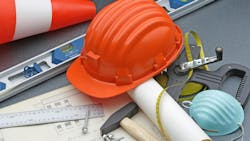Understanding Hazards on Construction Sites and The Importance of Safety Awareness
Construction sites are ever evolving. There are a multitude of different dynamic moving parts on every single construction site across the United States. From the operation of heavy machinery, complex job tasks, and the use of diverse materials, these sites present a large variety of risks. These risks are faced by all who come to a job site: visitors, contractors, and, most importantly, the men and women who are performing work at the site each day. This is what corresponds to the construction industry having the highest rate of workplace injuries and fatalities. When on these active job sites, there are two major things every person will need: safety awareness and hazard identification. This is vital to protect workers and visitors who are on site.
Understanding hazards on construction sites
The first step of safety awareness is understanding the full array of potential hazards associated with construction sites. These hazards can be placed into several categories below.
-
Environmental hazards — Job sites can vary in extreme weather conditions, including both cold and hot weather. These conditions can put workers in environments with ice, snow, and extreme temperatures, which adversely affect the work being completed and can present health challenges.
-
Physical hazards — The major physical hazards come from OSHA’s Focus 4. This includes falls, caught-in-between, struck-by, and electrocution. These main four physical hazards are what make up most workplace injuries or death.
-
Ergonomic hazards — The work being completed on construction sites tends to see musculoskeletal or soft tissue injuries. This trend on construction sites is usually due to repetitive motion, improper body positioning, and incorrect lifting techniques.
-
Mechanical hazards — Job sites are inundated with heavy machinery both on the exterior and interior of buildings. On the outside of the building, workers or visitors may find cranes, excavators, or even bulldozers. Inside buildings under construction, workers and visitors may find scissor lifts, man lifts, boom lifts, etc. Using without proper training and/or inspection can lead to serious accidents.
-
Chemical/substance hazards — Some major concerns on job sites are when there is potential exposure to asbestos, lead, and cement dust, also known as silica. These are some examples where workers can be presented with a challenge to ensure that their safety and health isn’t jeopardized. If these hazards are not identified prior to the start of work — and the proper PPE isn’t utilized — workers can be subjected to respiratory issues, skin irritation, and even long-term diseases like cancer or mesothelioma.
-
Electrical hazards — Electrical systems on job sites introduce workers to potential electrical shock or even fires. Improper use of LOTO devices, GFCIs, or correct extension cords can present major safety hazards.
The importance of safety awareness
-
Advocating for a safety culture — Promoting a safety culture should be a priority of every job site. This goal between management, workers, and subcontractors can create a culture where everyone has the same mindset when it comes to safety on the site. When safety is integrated into the site, the hope is that all workers will look out for each other and will rely on safety to help make decisions and complete tasks.
This fosters an open line of communication between safety departments and workers on site. It will also allow workers to feel comfortable reporting concerns, near misses, and unsafe conditions. Employers can then act on these reports and prevent serious incidents before they occur.
-
Injury and accident prevention — The goal of safety awareness is to prevent accidents and injuries. Safety awareness starts with training. Things like site safety orientation, company training, and toolbox talks are all vital in helping move toward a safer job site. The more workers that understand the hazards presented before them, the more injuries and accidents that can be avoided and prevented. Another big piece to this is ensuring that unsafe conditions and behaviors are corrected consistently.
-
Long-term health and wellbeing — Construction workers may face long-term health challenges if they are not educated on the possible risks associated with the work they do. By sponsoring safety awareness, employers can help mitigate these risks and protect the long-term health of their workforce. Another major key in today’s workforce is ensuring mental health is prioritized and that there are available options for workers to contact in case they need help.
-
Legal and financial responsibility — In addition to the ethical responsibility to keep workers safe, construction companies are legally obligated to adhere to workplace safety regulations. Compliance with occupational health and safety standards, such as those set forth by the Occupational Safety and Health Administration (OSHA), not only help to avoid fines and penalties but also protect against costly lawsuits. If a worker is injured or killed on the job due to negligence or failure to follow safety standards, the financial repercussions can be devastating to a company’s reputation and bottom line. Moreover, maintaining a safe worksite can reduce insurance premiums and liability risks. Companies with excellent safety records are seen as more reliable and responsible, leading to better relationships with clients and stakeholders.
Conclusion
Safety is a shared responsibility. All people involved in making a job site safe have a part to play in ensuring hazards and safety awareness are prioritized and understood. By promoting safety awareness, construction companies protect their workers, comply with legal requirements, reduce costs, and enhance the overall success of the project.
Investing in safety is not just about following regulations; it is about fostering an environment where workers are respected, their well-being is a priority, and everyone can return home safely at the end of the day. Safety awareness is not just a responsibility; it’s a fundamental element of a construction site’s culture — one that ultimately drives success for everyone involved.
About the Author

Kevin Kolhonen
Kevin Kolhonen is an experienced safety professional with a demonstrated history of working in the insurance/safety fields with specialization in the energy, construction, and transportation sectors. Currently, he is the health and safety manager at JM Electrical, a specialized electrical contractor in Greater Boston. As safety manager, Kolhonen is responsible for wide-ranging assignments, including the implementation, management, and maintenance of the company’s safety policies, procedures, compliance plans, and improvement initiatives. He also monitors industry regulations, visits construction sites to ensure the safety of the JME team, and establishes communications with field supervisors and field staff among other stakeholders. A graduate of Salem State University, Kolhonen brings significant experience in employee health and safety, loss prevention, and risk management to his role at JME. You can reach Kevin Kolhonen at [email protected] and learn more about JM Electrical at www.jmelectrical.com.
